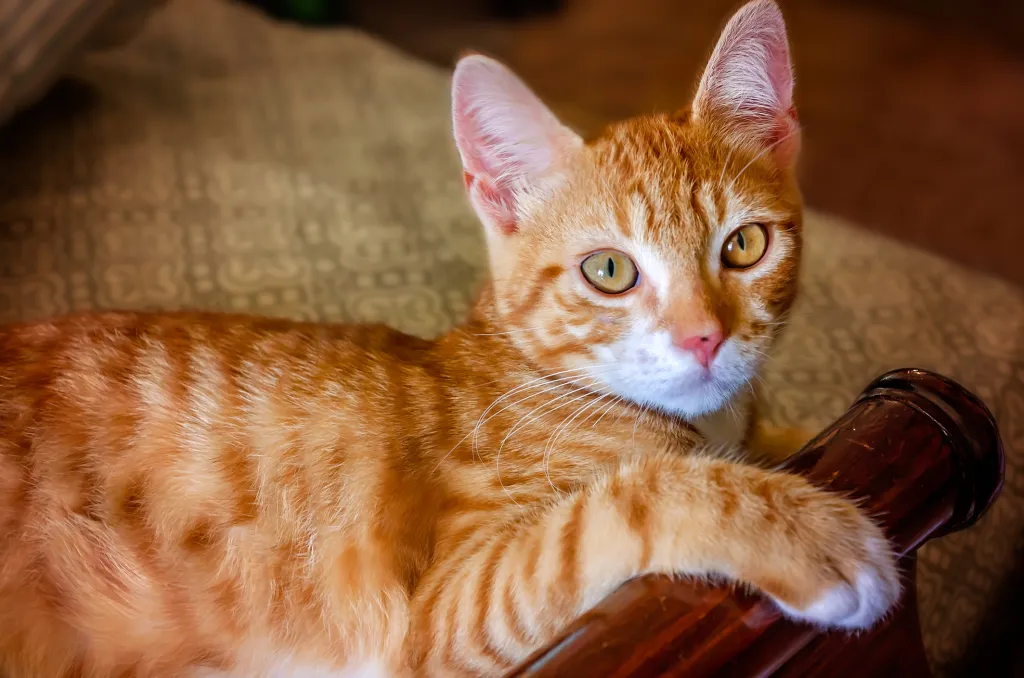Lentigo in cats is a common dermatological condition characterized by the presence of small, flat, brownish spots on the skin — particularly around the lips, nose, and eyelid margins. Unlike in humans — where lentigines may raise concerns about skin health — in cats, these spots are typically harmless and purely a cosmetic issue. They are more commonly observed in cats with lighter coat colors but can occur in cats of any coat type.
Here’s what you should know about the symptoms, causes, and treatments for the condition.
Symptoms of lentigo in cats
Lentigo primarily manifests as small, darkly pigmented spots, similar to freckles in humans. These spots are usually circular or irregularly shaped and can vary in size from a pinpoint to several millimeters in diameter. The most common areas you might notice these spots include around the lips, on the nose, and along the edges of the ears. Although less common, they can also appear on the gums, eyelids, or even the skin of the abdomen.
In cats, lentigo typically begins to appear in young adulthood and may increase in number as your cat ages. Unlike other skin conditions, lentigo spots are flat and do not cause any discomfort — such as itching, pain, or irritation — to cats. They simply present as a cosmetic difference, which should not affect your pet’s quality of life. However, it is crucial to observe any changes in the spots — including rapid growth or the development of texture — as it could indicate a different, potentially more serious condition requiring veterinary attention.
Causes of lentigo in cats

The exact cause of lentigo in cats is not well understood, but it is believed to be linked to genetics. As a result, the condition is more prevalent in certain cat colors or patterns. Orange, ginger, calico, and tortoiseshell cats seem to be more predisposed to developing these spots. Furthermore, the condition tends to occur more often in cats with light-colored or thin coats, possibly because the pigmentation is more visible against their skin.
Despite its appearance, lentigo does not result from sun exposure, a common misconception due to its similarity to sun-induced freckles in humans. Nonetheless, some researchers believe that the genetic makeup of ginger cats and their offspring can be unstable, leading to genetic alterations that trigger increased melanin production. Melanin — produced by melanocyte cells — plays a critical role in determining the color of skin and hair.
To diagnose lentigo, your veterinarian will closely inspect the pigmented spots on your cat’s skin. They might use a dermatoscope — a special magnifying tool — to examine the spots more closely. Additionally, your vet may ask you about your cat’s medical history, exposure to sunlight, and any recent changes in the appearance of the spots. To rule out other conditions, such as skin infections, fungal infections, or skin cancer, the vet may perform a biopsy, taking a small sample of the affected area for laboratory analysis. This step is crucial to ensure that the dark spots are indeed lentigo and not indicative of a more serious health issue.
Treatments for lentigo in cats
Given that lentigo in cats is a benign condition, treatment is not typically necessary. The primary focus should be on monitoring the spots for any changes that deviate from their original appearance. If you notice any rapid growth, changes in color or shape, or if the spots become raised or irritated, it’s crucial to consult with a veterinarian. These changes could be indicative of a more serious skin condition like melanoma. Therefore, early diagnosis and treatment are key to successful management.
For cosmetic reasons, some owners might inquire about treatment options to lighten or remove the spots. However, most veterinarians advise against pursuing such measures due to the unnecessary risk of discomfort or complications from cosmetic procedures on animals. Instead, the best course of action is to embrace your kitty’s unique appearance. That said, remember to schedule regular wellness checks with your veterinarian to catch any potential health issues early on.









